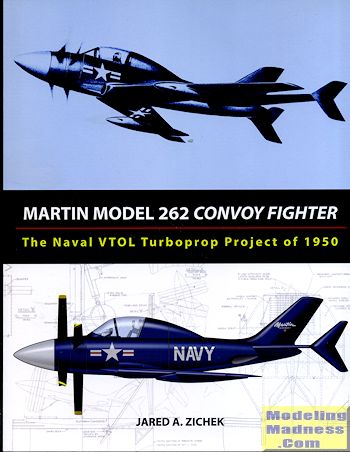 This is Jared
A. Zichek's second volume covering the Navy's proposal during the late 1940s and
early 1950s that led to the Convair XFV-1 and Lockheed's XFY-1 VTO fighter
prototypes. During the
last years of WWII and into the 1950s, the pace of aviation development was
staggering. Advances were coming so quickly that what was top of the line one
year, was nearing obsolescence just a few years later. It was also a time of
innovation where the military was not afraid to try something new and designers
were more than happy to stretch their abilities as well.
This is Jared
A. Zichek's second volume covering the Navy's proposal during the late 1940s and
early 1950s that led to the Convair XFV-1 and Lockheed's XFY-1 VTO fighter
prototypes. During the
last years of WWII and into the 1950s, the pace of aviation development was
staggering. Advances were coming so quickly that what was top of the line one
year, was nearing obsolescence just a few years later. It was also a time of
innovation where the military was not afraid to try something new and designers
were more than happy to stretch their abilities as well.
Such was the case of the Convoy Fighter. This was a plan to
allow ships in a convoy to carry a plane or two for self protection against
enemy bombers without the requirement for a large and expensive aircraft
carrier. The specifications called for a turboprop powered aircraft that could
land and take off vertically without the need for complex handling apparatus. It
should also be able to operate from a ship that was moving and so had to be able
to handle not only fore and aft movement but also side to side motion. These are
the motions that make most first time voyagers sea-sick.
Proposals were submitted by several companies and two were
chosen as noted in the opening. However, only one of those was able to lift off
from the ground vertically, such was the state of turboprops of the era. It
wasn't because the aircraft were too heavy as the Convair and Lockheed
prototypes were the lightest of the five proposals. It was due to the lack of
power from the XT-40 turboprop, an engine that never really was able to meet its
full requirements of power and reliability.
This edition is on the Martin Model 262 proposal. This
aircraft was the only one of the five that was not initially designed to take
off while standing on its tail. Instead, the aircraft would be attached to a
large board-like structure on the ship by a long spike that fit into what on a
regular plane would be the nose gear bay. This was somewhat similar to the
method of launching and recovering the Ryan X-13 Vertijet. The Martin proposal
was the only one that had swept wings.
Martin also offered three other options, all of them somewhat
different from the initial Model 262. Martin felt that wind tunnel data was
needed to determine the proper shape of the project before building a prototype.
This would have been done had a contract been signed. For whatever reason
(excess weight was stated, but many think that Martin's offering of alternate
proposals showed a lack of trust in its initial design), Martin was not offered
the contract and the project joined many others in the fog of time.
In this book, the author covers every known aspect of the
Model 262 and includes a wealth of engineering drawings of the aircraft in
question. The three alternate proposals are also covered in detail as are the
various methods of landing and taking off from a ship. There are artists impressions of these aircraft as well as full
color profiles of what might have been. It makes for a fascinating look into
what might have been and sheds some light on a little known aviation project.
Copyright ModelingMadness.com October 2015
My thanks to
www.retromechanix.com for providing the review
sample. You can get yours
here.
If you would like your product reviewed fairly and fairly quickly, please contact
the editor or see other details in the Note to
Contributors.
Back to the Main Page
Back to the Books Index
Page
 This is Jared
A. Zichek's second volume covering the Navy's proposal during the late 1940s and
early 1950s that led to the Convair XFV-1 and Lockheed's XFY-1 VTO fighter
prototypes. During the
last years of WWII and into the 1950s, the pace of aviation development was
staggering. Advances were coming so quickly that what was top of the line one
year, was nearing obsolescence just a few years later. It was also a time of
innovation where the military was not afraid to try something new and designers
were more than happy to stretch their abilities as well.
This is Jared
A. Zichek's second volume covering the Navy's proposal during the late 1940s and
early 1950s that led to the Convair XFV-1 and Lockheed's XFY-1 VTO fighter
prototypes. During the
last years of WWII and into the 1950s, the pace of aviation development was
staggering. Advances were coming so quickly that what was top of the line one
year, was nearing obsolescence just a few years later. It was also a time of
innovation where the military was not afraid to try something new and designers
were more than happy to stretch their abilities as well.